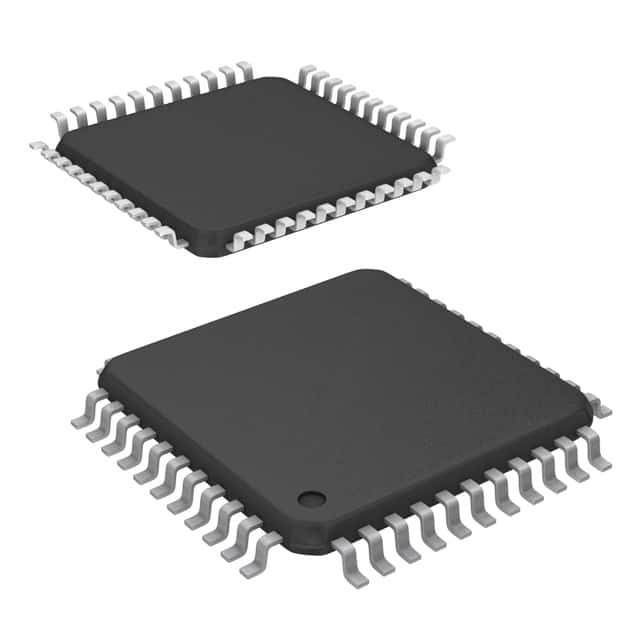EPM7032AETA44-10N
Product Overview
Category
The EPM7032AETA44-10N belongs to the category of programmable logic devices (PLDs).
Use
This device is commonly used in digital circuit design and implementation. It provides a flexible and customizable solution for various applications.
Characteristics
- Programmable: The EPM7032AETA44-10N can be programmed to perform specific functions based on the user's requirements.
- High Integration: It offers a high level of integration, allowing multiple logic functions to be implemented within a single device.
- Versatile: This PLD supports a wide range of applications, making it suitable for diverse industries.
- Reliable: The EPM7032AETA44-10N is known for its reliability and stability in operation.
Package
The EPM7032AETA44-10N comes in a 44-pin TQFP (Thin Quad Flat Pack) package.
Essence
The essence of this product lies in its ability to provide a reconfigurable logic solution, enabling designers to implement complex digital circuits efficiently.
Packaging/Quantity
The EPM7032AETA44-10N is typically packaged individually and is available in various quantities depending on the manufacturer or supplier.
Specifications
- Device Type: Programmable Logic Device (PLD)
- Family: EPM7000
- Number of Macrocells: 32
- Operating Voltage: 3.3V
- Speed Grade: 10 nanoseconds
- Package Type: TQFP
- Package Pins: 44
- Temperature Range: -40°C to +85°C
Detailed Pin Configuration
The EPM7032AETA44-10N has a total of 44 pins. Here is a detailed pin configuration:
- VCCIO
- GND
- I/O0
- I/O1
- I/O2
- I/O3
- I/O4
- I/O5
- I/O6
- I/O7
- I/O8
- I/O9
- I/O10
- I/O11
- I/O12
- I/O13
- I/O14
- I/O15
- I/O16
- I/O17
- I/O18
- I/O19
- I/O20
- I/O21
- I/O22
- I/O23
- I/O24
- I/O25
- I/O26
- I/O27
- I/O28
- I/O29
- I/O30
- I/O31
- GND
- VCCIO
- TCK
- TDI
- TDO
- TMS
- GND
- VCC
- GND
- NC
Functional Features
- Reconfigurable Logic: The EPM7032AETA44-10N allows users to program and reprogram the device to perform different logic functions.
- High-Speed Operation: With a speed grade of 10 nanoseconds, this PLD can handle complex digital operations efficiently.
- Flexible I/O Configuration: The device offers a wide range of input/output options, providing flexibility in connecting with external components.
- Low Power Consumption: The EPM7032AETA44-10N is designed to operate with low power consumption, making it suitable for battery-powered applications.
Advantages and Disadvantages
Advantages
- Flexibility: The ability to reconfigure the device allows for easy adaptation to changing design requirements.
- Integration: The high level of integration reduces the need for additional components, saving space and cost.
- Customization: Users can tailor the device to their specific application needs, optimizing performance.
Disadvantages
- Learning Curve: Programming and utilizing PLDs may require a learning curve for users unfamiliar with digital circuit design.
- Limited Resources: The number of macrocells and available resources may restrict the complexity of designs that can be implemented.
Working Principles
The EPM7032AETA44-10N operates based on the principles of programmable logic. It consists of configurable logic blocks (CLBs), interconnect resources, and input/output blocks (IOBs). The CLBs contain look-up tables (LUTs) that can be programmed to implement various logic functions. The interconnect resources allow for the routing of signals between different CLBs and IOBs. The IOBs provide the interface between the PLD and external components.
Detailed Application Field Plans
The EPM7032AETA44-10N finds applications in various fields, including:
- Industrial Automation: Used in control systems
Lista 10 Vanliga frågor och svar relaterade till tillämpningen av EPM7032AETA44-10N i tekniska lösningar
Sure! Here are 10 common questions and answers related to the application of EPM7032AETA44-10N in technical solutions:
Q: What is EPM7032AETA44-10N? A: EPM7032AETA44-10N is a specific model of programmable logic device (PLD) manufactured by Intel.
Q: What is the purpose of EPM7032AETA44-10N? A: EPM7032AETA44-10N is used for implementing digital logic functions in various electronic systems and applications.
Q: What are the key features of EPM7032AETA44-10N? A: Some key features include 32 macrocells, 32 inputs/outputs, 44-pin TQFP package, and a maximum operating frequency of 10 MHz.
Q: How can EPM7032AETA44-10N be programmed? A: EPM7032AETA44-10N can be programmed using industry-standard hardware description languages (HDLs) like VHDL or Verilog.
Q: What are some typical applications of EPM7032AETA44-10N? A: EPM7032AETA44-10N is commonly used in applications such as industrial control systems, communication equipment, automotive electronics, and consumer electronics.
Q: Can EPM7032AETA44-10N be reprogrammed after initial programming? A: No, EPM7032AETA44-10N is a one-time programmable (OTP) device and cannot be reprogrammed once it has been programmed.
Q: What is the power supply voltage range for EPM7032AETA44-10N? A: The recommended power supply voltage range for EPM7032AETA44-10N is typically between 4.75V and 5.25V.
Q: What is the maximum current consumption of EPM7032AETA44-10N? A: The maximum current consumption of EPM7032AETA44-10N is typically around 100mA.
Q: Can EPM7032AETA44-10N operate in harsh environments? A: Yes, EPM7032AETA44-10N is designed to operate reliably in a wide temperature range and can withstand certain levels of shock and vibration.
Q: Are there any specific programming tools required for EPM7032AETA44-10N? A: Yes, you will need a compatible programmer or development board that supports programming of EPM7032AETA44-10N devices.
Please note that the answers provided here are general and may vary depending on the specific requirements and datasheet of the device.


